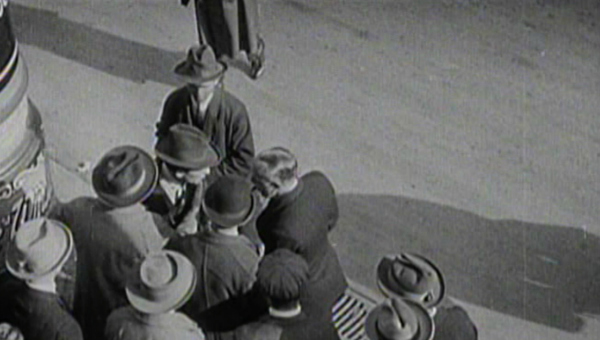Walter Ruttmann’s classic portrait of 1920s Berlin can be enjoyed equally as reportage, social analysis or visual poem.
The opening three minutes of BERLIN, SYMPHONY OF A GREAT CITY show a train racing towards the city of the title. In addition to positioning the viewer as a visitor and establishing the contrast between the urban landscape and the countryside that surrounds it, this sequence introduces three elements of director Walter (here credited as Walther) Ruttmann’s style that become very familiar in the proceeding film – first, and most obviously, a sense of perpetual motion; second, a tendency towards geometric abstraction; third, a preference for the monumental over the specific. As the sequence cleverly ends with a close-up of the railway station’s sign, ‘BERLIN’, one could perhaps add a fourth motif: the sheer volume and variety of lettering all over the city, which might be said to stand in for the film’s lack of inter-titles.
Ruttmann is able to find images of great formal beauty throughout the film…
Ruttmann divides his film into five ‘acts’, covering some eighteen hours of what appears to be a single day. The first three of these correspond to the morning, from 5 am to midday, ‘Act IV’ is the afternoon and ‘Act V’ the night. The city begins almost entirely empty of people, save for a few stragglers coming home from the previous night’s revels. Factory workers – first one, then a second and a third, and finally a great mass – begin to make their way through the streets towards their workplaces. Once they are at work, Ruttmann makes much of the shapes and patterns of industrial machinery in motion, as Dziga Vertov would do a few years later in MAN WITH A MOVIE CAMERA (markedly similar to this film in so many ways). Despite the real-life subject matter, Ruttmann is able to find images of great formal beauty throughout the film, and a particular highlight comes towards the end, with the gorgeous, high-contrast chiaroscuro of the night-time street scenes.
One particularly fascinating structural repetition in the film, perhaps representing Ruttmann’s social concerns, is the sense of this dynamic, apparently thriving city spiralling out of control. The images of a business at work – the secretaries typing, the boss making calls – become more and more frenzied, until Ruttmann cuts suddenly to a pair of monkeys chattering away, then to two dogs fighting. The film has frequent recourse to other, often equally satirical, imagery involving animals. The relaxation of the city as everyone stops for lunch, for example, is shown by a series of animals, including an elephant, lying down to rest. The end of this brief period of leisure is shown by the same elephant getting up again.
“The film, much like the city, seems to give itself wholly over to pleasure…”
This sense of a barely-controlled hysteria underlying the city’s activity is shown even more clearly later on. The film shows the word ‘Geld’ (money) repeatedly jumping out of newspaper text, cuts to a literal roller coaster ride, then goes to a close-up – one of a very few in the entire film – of an unkempt, wide-eyed woman on a bridge, about to throw herself into the river. This scene must have been staged, and there are a few other examples where Ruttmann the director may have been overwhelmed by Ruttman the showman – a sudden fight on the street between two men, with a crowd looking on in fascination, or a man picking up a prostitute.
Ruttmann is keen to show the inequalities of income within Berlin, and rarely fails to match one image of wealthy excess to another of dire poverty. A shot of a cigarette discarded by a wealthy individual about to catch a taxi, for example, is immediately followed by a tramp picking up butts from the pavement. However, in the final ‘act’, as the sun down and lights coming on all over the city, everything changes. As if beguiled by the variety and exuberance on offer in Berlin’s theatres, dance-halls and gaming establishments, the film, much like the city, seems to give itself wholly over to pleasure.
BERLIN, SYMPHONY OF A GREAT CITY is boldly credited as ‘Ein Film von Walther Ruttmann’. However, Ruttmann worked closely with the cinematographer Karl Freund, developing an original idea by the scenarist of THE CABINET OF DR CALIGARI, Carl Mayer. Credit must also go to the composer of the orchestral score, Edmund Meisel (best known for his collaborations with Eisenstein on BATTLESHIP POTEMKIN and OCTOBER), whose music is integral to the success of the film.
httpvh://www.youtube.com/watch?v=qqhI42tH5vw



